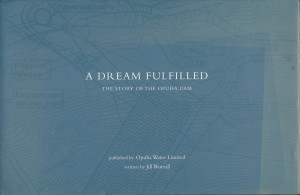History of the Dam Project
The Opuha Dam, which is situated at the confluence of the North and South Opuha Rivers 17 kms north-east of Fairlie, is an infrastructure project undertaken by the community of South Canterbury. The actual project itself consists of a 50 metre high earth dam, with a single hydro turbine and a lake covering up to 710 hectares and storing over 74 million cubic metres of water.
The lake provides water to maintain environmental flows in the downstream catchment and for irrigation as well as urban and industrial supplies. Renewable hydro electricity is generated with all the water released from the dam.
Water storage is prioritised for release into the Opuha River which flows into Opihi River to ensure minimum flows are maintained at all times and especially in times of drought and/or low natural flows.
 Initially, the concept came out of discussions between the Electricity Corporation of New Zealand (ECNZ) and the Opihi Augmentation Society, and resulted in the Opuha Dam Partnership being formed back in 1992 to commercialise the project. At this time, it enjoyed the support of local Lines Company, Alpine Energy Ltd, Timaru and MacKenzie District Councils, the Opihi River Development Company and two irrigation companies – Levels Plain Irrigation Company Ltd (which existed prior to the dam) and South Canterbury Farmers Irrigation Society (SCFIS) which was established to represent the farmers who would in future be able to access water from the dam.
Initially, the concept came out of discussions between the Electricity Corporation of New Zealand (ECNZ) and the Opihi Augmentation Society, and resulted in the Opuha Dam Partnership being formed back in 1992 to commercialise the project. At this time, it enjoyed the support of local Lines Company, Alpine Energy Ltd, Timaru and MacKenzie District Councils, the Opihi River Development Company and two irrigation companies – Levels Plain Irrigation Company Ltd (which existed prior to the dam) and South Canterbury Farmers Irrigation Society (SCFIS) which was established to represent the farmers who would in future be able to access water from the dam.
Construction of the dam began in 1995 and progressed very successfully until Waitangi Day 1997 when three days of solid rain in the upper catchment resulted in the partially completed dam being overwhelmed and breached by the high inflows. While there was extensive damage downstream and to the construction site, the project faced only a temporary set back. Repairs were swiftly completed and the project was commissioned and officially opened in November 1998.
After nearly ten years of initial operation, the scheme was purchased outright by the farmer irrigators who are now 100% shareholders of the ownership company Opuha Water Ltd.
The project has been immensely successful for the economic prosperity of the region and has enabled the development of a robust agricultural sector covering a wide range of land use activities. These include dairying, horticulture and arable cropping, sheep, beef and deer and specialist seed growing. These on-farm activities support significant downstream industries such as the vegetable processing facilities at Washdyke, dairy processing and represent a significant part of the region’s export economy and earnings.
The lake itself provides excellent amenity value, especially for the local Fairlie community where the lake provides recreational benefits which people from Timaru and Ashburton also come to enjoy. The lake is an increasingly popular destination for the region’s schools as part of their rowing and water based activities and programmes.
The Opihi catchment is experiencing the same challenges as most freshwater catchments in Canterbury with concerns over the reducing water quality of the rivers and streams and the impacts this has had on amenity value and in-stream aspects including the fishery. While the dam has resulted in better river flows being maintained throughout the year with positive results such as maintaining the river mouth opening, understanding the impact of the dam on water quality and what improvements may be able to be made continues to be a focus for Opuha Water Limited.
Opuha Book ‘A Dream Fulfilled’
John Keast, 1 December 2007, The Press (Christchurch)
The story of the Opuha Dam is a story of South Canterbury, and now it is told in a book.
Drought is the curse of the land and it came to South Canterbury in the 1980’s and did not leave. It sucked the life out of the land and eroded the spirit of those farming it, and, in a strange way, it created a revolution. South Canterbury, then, had little in the way of irrigation – and there are constant cries still for more water – but the terror of the nor’west winds of 1982, 1985 and 1988 focused as never before the minds of those whose job it was to tend stock and raise crops.
Tom Henderson was one of those men. He is retired now, and living in Pleasant Point, but he could see then the need for water storage. It was, he says, the only way to get around drought. He believed then, as now, that if the region was to have a prosperous future, it had to come from the land. Henderson was instrumental in forming the Opihi River Augmentation Society, a wordy title for a group that became the driving force that led to the creation of the Opuha Dam near Fairlie. Much has been written about that dam; about its creation – its devastating collapse – and its rebuilding.
Timaru author Jill Worrall has wrote a book on the dam – A Dream Fulfilled, The Story Of The Opuha Dam – for Opuha Water.
 Worrall’s book is more than a set of facts and photos; it is about the tenacity of South Cantabrians; about guts and drive and an unswerving will to succeed. It is also, in no short measure, about politics, pressure, disappointment, elation and drought. Now, the dam, and its associated irrigation scheme, are held up – and rightly so – as what can be achieved when water can be stored. In South Canterbury’s case, it is much.
Worrall’s book is more than a set of facts and photos; it is about the tenacity of South Cantabrians; about guts and drive and an unswerving will to succeed. It is also, in no short measure, about politics, pressure, disappointment, elation and drought. Now, the dam, and its associated irrigation scheme, are held up – and rightly so – as what can be achieved when water can be stored. In South Canterbury’s case, it is much.
The dam, giving surety of water supply to farms, has led to the creation of 500 new jobs; augmented the Opihi River to the point where once again it is an anglers’ delight; created a very popular recreational lake near Fairlie, and, not least, generates electricity. And it was all done by private enterprise at a time when the Government was the only body building dams or creating anything like a major project.
Tom Henderson is delighted with the project – and he has every right. He reckons having local people on the project was a major reason for its success. Now, the scheme is owned by its farmer shareholders, giving Henderson real confidence in its future for the benefit of the whole community. But to know its success is also to know of the dam’s big failure. Few will have forgotten the news of February 6, 1997. It was calm in Timaru, but near Fairlie, a lake began to form behind the dam, fed by three days of steady rain. It rose and rose and, eventually, led to the breaching of the dam, sending a thundering wall of water towards the Skipton Bridge, punching it out, and then into the Opuha and Opihi river systems. More than 200 people were evacuated and, almost unbelievably, no one was killed as the water surged to the sea. More than 1000 animals, though, lost their lives. The breach caused $8m worth of damage to the dam, and downstream farms suffered losses of around $4m. South Canterbury, for all the wrong reasons, was in the national news. The devastation was huge; the dam gutted and rent apart. It was fixed, at no small cost, to be the success it is today, a decade on. But that breach led to prosecutions by the regional council, ECan, something that still rankles in South Canterbury – and something not forgotten today as various councils in Mid and South Canterbury talk loudly about the likelihood of backing the formation of a central South Island regional council.
Former Timaru Mayor Wynne Raymond says now of the prosecution of Chris Hollingum, the foreman of dam contractor Doug Hood Ltd: “Chris Hollingum deserved a medal, not a criminal charge. What the regional council did to him is still a source of utter fury – even today.”
After its breach it took nine months to put the dam back to the state it was before its collapse. On a sunny day on November 7, 1998, the dam was opened. It was a red-letter day for South Canterbury. The late Sir Peter Elworthy arrived in his yellow Tiger Moth and, thudding in from the coast, came a World War 2 fighter. It was stirring stuff; a dream turned reality. Worrall’s book has captured it all. The dam story is one of grit and courage, of the triumph of individuals. It is, frankly, a good dam read.
Copies of the book, ‘A Dream Fulfilled, The Story of the Opuha Dam’ are available for purchase for $30.00 each from the Opuha office or by emailing office@opuha.co.nz.




